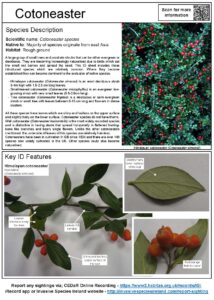Cotoneaster
Cotoneaster spp.
Overview
Photo credit: ©GBNNSS (Wall cotoneaster)
Cotoneaster - Cotoneaster spp.
Description:
- A large group of small trees that are evergreen or deciduous, with bright red berries. In most species, the leaves tend to have a hairy underside. Wall cotoneaster is a common species, and is identified by its herring-bone-like branches and single flowers. The underside of its leaves are hairless.
Origin and Worldwide Distribution:
- The majority of the species originate from East Asia. Many species have become invasive in the United Kingdom, Austria, Australia, Germany, Belgium, Czechia, France, Hungary, Ireland, Italy, Luxembourg, Norway, Canada, the United States of America, Argentina, Poland and Switzerland.
Potential or Known Impacts:
- It spreads rapidly across local areas as their seeds are eaten by birds. It poses a threat to local biodiversity as it readily invades high priority habitats, like limestone grasslands, and can out-compete native species. It may also be seen in lower quality habitats, and may become the dominant species by smothering native species.
How did it get here?
- It was introduced as an ornamental plant for gardens and landscaping, but was quickly spread by birds eating the seeds.
Is it found in Northern Ireland?
- Found in Northern Ireland.
- Distribution maps can be seen here on NBN Atlas Northern Ireland
Methods for Prevention:
- Record any sightings here.
You can help by reporting any sightings: @ the Centre for Environmental Data & Recording (CEDaR) - Or via the iRecord App.
For further queries, you can contact the Invasive Non Native Species (INNS) Team in the Northern Ireland Environment Agency on 028 9056 9558 or Email: invasivespecies@daera-ni.gov.uk

